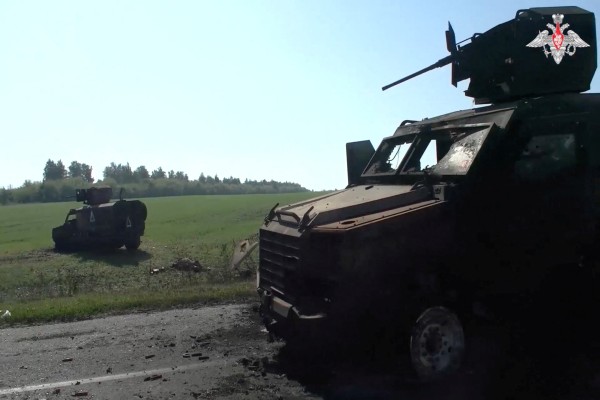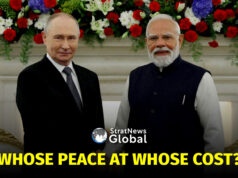Western military analysts project the Ukrainian offensive in Kursk which began on August 6 as a major psychological boost for the embattled country.
Russia, however, say the offensive, which involved ‘crack troops and foreign mercenaries” and an “array of NATO equipment”, exposed how ineffective the latest Western weapons systems were against Russian firepower.
Claiming that Russian forces had wiped out over 6,200 Ukrainian troops and 73 tanks in the first 20 days of the incursion, Moscow said Kursk, some 400 km northeast of Kyiv, has become a “graveyard for NATO armour”.
Graveyard for NATO armor:
List of Western weapons systems destroyed during Kiev’s Kursk gambit
Challenger 2: Britain’s battle-shy MBT
20 Abrams tanks
3 HIMARS rocket artillery
Dozens of Canadian APC-IFV hybrids
3 German “Schutzenpanzers”
8 US Bradley
100 armored vehicles pic.twitter.com/gamuyM9KZ3— Lee Golden (@LeeGolden6) August 26, 2024
And to back this assertion, Moscow recently released a list of NATO-supplied weapons that had been destroyed during ”Kyiv’s Kursk gambit.”
These include:
The Challenger 2 Main Battle Tank (Great Britain):
Battle damage on British Challenger 2 in Ukraine. Judging by the traces on the armor, the tank was hit 3 times probably by a FPV-Drones or an ATGMs. pic.twitter.com/ESD6HsFzIy
— War Armor (@WarArmor13) August 15, 2024
Britain’s battle-shy MBT lost its status as the only modern tank never to have been destroyed by enemy fire when a Russian loitering munition destroyed one in the Kursk region in mid-August.
Abrams Tank (U.S.)
Remember when we were told that the supply of US Abrams tanks to Ukraine would be a game changer as they were virtually indestructible? Well…this is an Abrams tank looking a bit … destroyed. pic.twitter.com/SMIxBAxJcC
— David Vance (@DVATW) August 21, 2024
Russia’s first Abrams kill in the Kursk region was reported last week, said one report, claiming at least 20 of the 31 Abrams supplied to Kiev have now been lost.
High Mobility Artillery Rocket System, or HIMARS (U.S.)
💥 Another HIMARS MLRS destroyed
Objective control footage confirmed an AFU HIMARS MLRS destroyed close to Stepanovka (Sumy region).
The missile strike was carried out by an Iskander-M operational-tactical missile system against the identified position of the U.S.-made HIMARS pic.twitter.com/76mgXKkC3J
— Global Report (@FarhadA45014410) August 27, 2024
At least three of these shoot-and-scoot rocket artillery systems have been destroyed in the Kursk assault, claimed Sputnik, the Russian state-controlled media outlet.
Bradley Infantry Fighting Vehicles (U.S.)
👀Kursk region: A destroyed Bradley infantry fighting vehicle stands in the middle of various burnt-out vehicles.🫡 pic.twitter.com/ePMKejzQU6
— SputnikSpreader (@VasBroughtToX) August 7, 2024
Eight of these American IFVs were destroyed in the course of 24 hours on August 12 during a breakthrough attempt, while ‘five or more were knocked out in fighting elsewhere,’ the Russians said.
Stryker (APV-IFV) (Canada)I
FV Stryker s odminovacímy traly, údajně na jihovýchodě Ukrajiny. pic.twitter.com/mnjtY8bzZB
— Bazilíšek (@Bazilis) April 7, 2023
About a dozen of these Canadian APC-IFV hybrids have been destroyed by Russian air power, Lancet drones, and Black Sea Fleet Naval Infantry in the Kursk region, while two were captured.
Marder tracked IFV (Germany)
German-supplied Marder 1A3 IFV in Ukrainian Air Assault service.
Confirmation that some Ukrainian Airmobile forces will be operating at least a mix of Marder IFVs and Challenger 2 MBTs. pic.twitter.com/9Tz5Vne1gW
— OSINTtechnical (@Osinttechnical) July 28, 2023
At least three of these German “Schutzenpanzers” have been knocked out by Russian forces in the Kursk region, said Sputnik.
Humvees (U.S)
🇷🇺🇺🇲 Humvee americano capturado em Kursk: pic.twitter.com/ZVVDJczO7x
— Operações militares globais (@GeoMilitarismo) August 21, 2024
‘These ubiquitous US-made High Mobility Multipurpose Wheeled Vehicle, better known as Humvees, have been spotted in MoD and media reports on destroyed enemy equipment, with knocked-out vehicles seen in an array of modifications, from machinegun turret-equipped variants to support vehicles,’ said the Sputnik report.
M113 APC (U.S)
Operation #Kursk
Here we are!
M113 APC and german “Wisent” mine-clearing armoured personnel carrier on russian soil… pic.twitter.com/DlG29u1NUR
— Boris Alexander Beissner (@boris_beissner) August 10, 2024
At least one M113 has been hit by Russia’s deadly new EW-resistant Knyaz Vandal of Novgorod wired FPV drone.
Russia’s counter attack
Apart from this, Russian forces unleashed major counter-attacks involving airstrikes, artillery barrages and infantry at over 12 places, say reports. Ukraine’s 22nd & 115th Mechanized brigades, 82nd Airborne Assault brigade, & Guard and Support brigade were some of the targets.
Russia also hit 16 locations in Ukraine’s Sumy region. According to the Kyiv Independent, Russian forces struck Sumy Oblast 229 times on August 25, killing three people and injuring six others.
It quoted the Sumy Oblast Prosecutor’s Office as saying Russia dropped a KAB guided aerial bomb onto a residential five-story building in the village of Svesy around 3 p.m. local time.
On Monday, The Russian defence ministry released a video showing a Lancet loitering munition decimating an Ukrainian radar station in Sumy region on August 25.
In a career spanning three decades and counting, Ramananda (Ram to his friends) has been the foreign editor of The Telegraph, Outlook Magazine and the New Indian Express. He helped set up rediff.com’s editorial operations in San Jose and New York, helmed sify.com, and was the founder editor of India.com.
His work has featured in national and international publications like the Al Jazeera Centre for Studies, Global Times and Ashahi Shimbun. But his one constant over all these years, he says, has been the attempt to understand rising India’s place in the world.
He can rustle up a mean salad, his oil-less pepper chicken is to die for, and all it takes is some beer and rhythm and blues to rock his soul.
Talk to him about foreign and strategic affairs, media, South Asia, China, and of course India.





